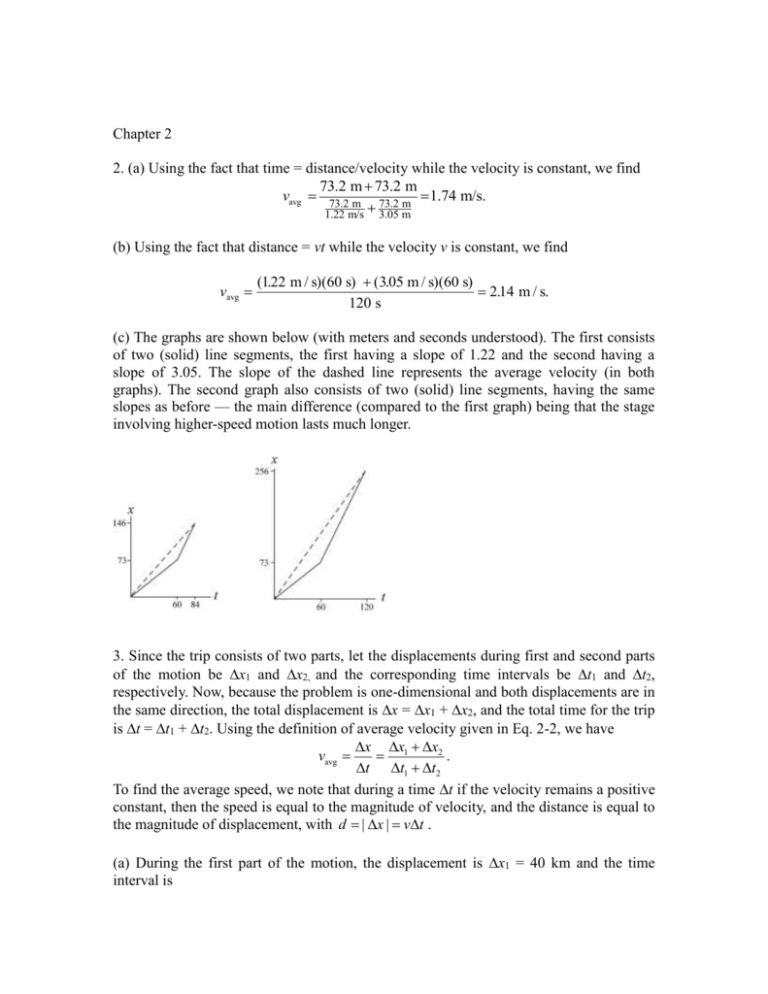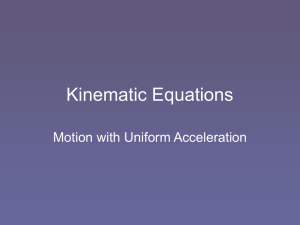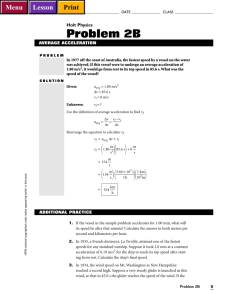Chapter 2
advertisement

Chapter 2 2. (a) Using the fact that time = distance/velocity while the velocity is constant, we find 73.2 m 73.2 m vavg 73.2 m 73.2 m 1.74 m/s. 1.22 m/s 3.05 m (b) Using the fact that distance = vt while the velocity v is constant, we find vavg (122 . m / s)(60 s) (3.05 m / s)(60 s) 2.14 m / s. 120 s (c) The graphs are shown below (with meters and seconds understood). The first consists of two (solid) line segments, the first having a slope of 1.22 and the second having a slope of 3.05. The slope of the dashed line represents the average velocity (in both graphs). The second graph also consists of two (solid) line segments, having the same slopes as before — the main difference (compared to the first graph) being that the stage involving higher-speed motion lasts much longer. 3. Since the trip consists of two parts, let the displacements during first and second parts of the motion be x1 and x2, and the corresponding time intervals be t1 and t2, respectively. Now, because the problem is one-dimensional and both displacements are in the same direction, the total displacement is x = x1 + x2, and the total time for the trip is t = t1 + t2. Using the definition of average velocity given in Eq. 2-2, we have x x1 x2 vavg . t t1 t2 To find the average speed, we note that during a time t if the velocity remains a positive constant, then the speed is equal to the magnitude of velocity, and the distance is equal to the magnitude of displacement, with d | x | vt . (a) During the first part of the motion, the displacement is x1 = 40 km and the time interval is t1 (40 km) 133 . h. (30 km / h) Similarly, during the second part the displacement is x2 = 40 km and the time interval is (40 km) t2 0.67 h. (60 km / h) The total displacement is x = x1 + x2 = 40 km + 40 km = 80 km, and the total time elapsed is t = t1 + t2 = 2.00 h. Consequently, the average velocity is vavg x (80 km) 40 km/h. t (2.0 h) (b) In this case, the average speed is the same as the magnitude of the average velocity: savg 40 km/h. (c) The graph of the entire trip is shown below; it consists of two contiguous line segments, the first having a slope of 30 km/h and connecting the origin to (t1, x1) = (1.33 h, 40 km) and the second having a slope of 60 km/h and connecting (t1, x1) to (t, x) = (2.00 h, 80 km). 17. We use Eq. 2-2 for average velocity and Eq. 2-4 for instantaneous velocity, and work with distances in centimeters and times in seconds. (a) We plug into the given equation for x for t = 2.00 s and t = 3.00 s and obtain x2 = 21.75 cm and x3 = 50.25 cm, respectively. The average velocity during the time interval 2.00 t 3.00 s is vavg which yields vavg = 28.5 cm/s. x 50.25 cm 2175 . cm t 3.00 s 2.00 s (b) The instantaneous velocity is v (4.5)(2.00)2 = 18.0 cm/s. dx dt 4.5t 2 , which, at time t = 2.00 s, yields v = (c) At t = 3.00 s, the instantaneous velocity is v = (4.5)(3.00)2 = 40.5 cm/s. (d) At t = 2.50 s, the instantaneous velocity is v = (4.5)(2.50)2 = 28.1 cm/s. (e) Let tm stand for the moment when the particle is midway between x2 and x3 (that is, when the particle is at xm = (x2 + x3)/2 = 36 cm). Therefore, xm 9.75 15 . tm3 tm 2.596 in seconds. Thus, the instantaneous speed at this time is v = 4.5(2.596)2 = 30.3 cm/s. (f) The answer to part (a) is given by the slope of the straight line between t = 2 and t = 3 in this x-vs-t plot. The answers to parts (b), (c), (d), and (e) correspond to the slopes of tangent lines (not shown but easily imagined) to the curve at the appropriate points. 19. We represent the initial direction of motion as the +x direction. The average acceleration over a time interval t1 t t2 is given by Eq. 2-7: v v(t2 ) v(t1 ) aavg . t t2 t1 Let v1 = +18 m/s at t1 0 and v2 = –30 m/s at t2 = 2.4 s. Using Eq. 2-7 we find aavg v(t2 ) v(t1 ) (30 m/s) (1 m/s) 20 m/s 2 . t2 t1 2.4 s 0 The average acceleration has magnitude 20 m/s2 and is in the opposite direction to the particle’s initial velocity. This makes sense because the velocity of the particle is decreasing over the time interval. 25. We separate the motion into two parts, and take the direction of motion to be positive. In part 1, the vehicle accelerates from rest to its highest speed; we are given v0 = 0; v = 20 m/s and a = 2.0 m/s2. In part 2, the vehicle decelerates from its highest speed to a halt; we are given v0 = 20 m/s; v = 0 and a = –1.0 m/s2 (negative because the acceleration vector points opposite to the direction of motion). (a) From Table 2-1, we find t1 (the duration of part 1) from v = v0 + at. In this way, 20 0 2.0t1 yields t1 = 10 s. We obtain the duration t2 of part 2 from the same equation. Thus, 0 = 20 + (–1.0)t2 leads to t2 = 20 s, and the total is t = t1 + t2 = 30 s. (b) For part 1, taking x0 = 0, we use the equation v2 = v20 + 2a(x – x0) from Table 2-1 and find v 2 v02 (20 m/s) 2 (0) 2 x 100 m . 2a 2(2.0 m/s 2 ) This position is then the initial position for part 2, so that when the same equation is used in part 2 we obtain v 2 v02 (0)2 (20 m/s) 2 . x 100 m 2a 2(1.0 m/s 2 ) Thus, the final position is x = 300 m. That this is also the total distance traveled should be evident (the vehicle did not "backtrack" or reverse its direction of motion). 30. We choose the positive direction to be that of the initial velocity of the car (implying that a < 0 since it is slowing down). We assume the acceleration is constant and use Table 2-1. (a) Substituting v0 = 137 km/h = 38.1 m/s, v = 90 km/h = 25 m/s, and a = –5.2 m/s2 into v = v0 + at, we obtain t 25 m / s 38 m / s 2.5 s . 5.2 m / s2 (b) We take the car to be at x = 0 when the brakes are applied (at time t = 0). Thus, the coordinate of the car as a function of time is given by x 38 m/s t 1 5.2 m/s 2 t 2 2 in SI units. This function is plotted from t = 0 to t = 2.5 s on the graph to the right. We have not shown the v-vs-t graph here; it is a descending straight line from v0 to v. 45. In this problem a ball is being thrown vertically upward. Its subsequent motion is under the influence of gravity. We neglect air resistance for the duration of the motion (between “launching” and “landing”), so a = –g = –9.8 m/s2 (we take downward to be the –y direction). We use the equations in Table 2-1 (with y replacing x) because this is a = constant motion: v v0 gt (2 11) 1 y y0 v0t gt 2 2 v 2 v02 2 g ( y y0 ) (2 15) (2 16) We set y0 = 0. Upon reaching the maximum height y, the speed of the ball is momentarily zero (v = 0). Therefore, we can relate its initial speed v0 to y via the equation 0 v 2 v02 2 gy . The time it takes for the ball to reach maximum height is given by v v0 gt 0 , or t v0 / g . Therefore, for the entire trip (from the time it leaves the ground until the time it returns to the ground), the total flight time is T 2t 2v0 / g . (a) At the highest point v = 0 and v0 2 gy . Since y = 50 m we find v0 2 gy 2(9.8 m/s 2 )(50 m) 31.3 m/s. (b) Using the result from (a) for v0, we find the total flight time to be T 2v0 2(31.3 m/s) 6.39 s 6.4 s . g 9.8 m/s 2 (c) SI units are understood in the x and v graphs shown. The acceleration graph is a horizontal line at –9.8 m/s2. In calculating the total flight time of the ball, we could have used Eq. 2-15. At t T 0 , the ball returns to its original position ( y 0 ). Therefore, 2v 1 y v0T gT 2 0 T 0 . 2 g 46. Neglect of air resistance justifies setting a = –g = –9.8 m/s2 (where down is our –y direction) for the duration of the fall. This is constant acceleration motion, and we may use Table 2-1 (with y replacing x). (a) Using Eq. 2-16 and taking the negative root (since the final velocity is downward), we have v v02 2 g y 0 2(9.8 m/s2 )(1700 m) 183 m/s . Its magnitude is therefore 183 m/s. (b) No, but it is hard to make a convincing case without more analysis. We estimate the mass of a raindrop to be about a gram or less, so that its mass and speed (from part (a)) would be less than that of a typical bullet, which is good news. But the fact that one is dealing with many raindrops leads us to suspect that this scenario poses an unhealthy situation. If we factor in air resistance, the final speed is smaller, of course, and we return to the relatively healthy situation with which we are familiar. 49. We neglect air resistance, which justifies setting a = –g = –9.8 m/s2 (taking down as the –y direction) for the duration of the motion. We are allowed to use Table 2-1 (with y replacing x) because this is constant acceleration motion. We are placing the coordinate origin on the ground. We note that the initial velocity of the package is the same as the velocity of the balloon, v0 = +12 m/s, and that its initial coordinate is y0 = +80 m. (a) We solve y y0 v0t 21 gt 2 for time, with y = 0, using the quadratic formula (choosing the positive root to yield a positive value for t). 2 2 v0 v02 2 gy0 12 m/s (12 m/s) 2 9.8 m/s 80 m t g 9.8 m/s 2 5.4 s (b) If we wish to avoid using the result from part (a), we could use Eq. 2-16, but if that is not a concern, then a variety of formulas from Table 2-1 can be used. For instance, Eq. 211 leads to v v0 gt 12 m/s (9.8 m/s 2 )(5.447 s) 41.38 m/s Its final speed is about 41 m/s. 77. Since the problem involves constant acceleration, the motion of the rod can be readily analyzed using the equations in Table 2-1. We take +x in the direction of motion, so b v 60 km / h 1000 m / km I gF G H3600 s / h J K 16.7 m / s and a > 0. The location where it starts from rest (v0 = 0) is taken to be x0 = 0. (a) Using Eq. 2-7, we find the average acceleration to be aavg v v v0 16.7 m/s 0 3.09 m/s 2 3.1 m/s 2 . t t t0 5.4 s 0 (b) Assuming constant acceleration a aavg 3.09 m/s2 , the total distance traveled during the 5.4-s time interval is 1 1 x x0 v0t at 2 0 0 (3.09 m/s 2 )(5.4 s) 2 45 m . 2 2 (c) Using Eq. 2-15, the time required to travel a distance of x = 250 m is: x 2 250 m 1 2 2x at t 13 s . 2 a 3.1 m/s 2 Note that the displacement of the rod as a function of time can be written as 1 x(t ) (3.09 m/s 2 )t 2 . Also we could have chosen Eq. 2-17 to solve for (b): 2 1 1 x v0 v t 16.7 m/s 5.4 s 45 m. 2 2










